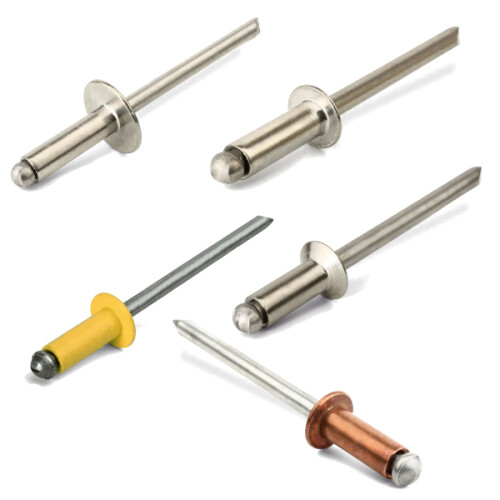Riveters
Rivet guns: essential tools for secure and durable fastening
Rivet guns are fundamental tools used for installing rivets, ensuring secure and long-lasting joints between two or more materials. These tools are widely employed across various industries, from construction and metalworking to the automotive and aerospace sectors.
Thanks to their ability to join materials permanently without the need for threading or welding, rivet guns provide an efficient and reliable solution for numerous industrial and craft applications.
Types of rivet guns
There are different types of rivet guns, each designed to meet specific application needs and operational conditions. The main categories include:
- Manual rivet guns: These tools are hand-operated and ideal for light-duty work or applications requiring greater precision. Manual rivet guns are commonly used in domestic settings, for small DIY projects, or in workshops where large numbers of rivets do not need to be installed. Although they require more physical effort compared to pneumatic or hydraulic models, they are lightweight, portable, and easy to use.
- Pneumatic rivet guns: Powered by compressed air, these rivet guns allow for quick and effortless rivet installation, making them ideal for industrial applications or scenarios where large numbers of rivets need to be installed efficiently. Pneumatic rivet guns are particularly valued in the automotive sector and mass production, where speed and process repeatability are essential.
- Hydraulic rivet guns: These tools use a hydraulic system to apply high force, enabling the installation of large rivets or structural rivets in thick and resistant materials. Hydraulic rivet guns are used in sectors such as heavy construction, shipbuilding, and aerospace industries, where exceptionally strong and reliable joints are required.
- Electric or battery-powered rivet guns: These rivet guns are powered by an electric motor or a rechargeable battery, offering a good compromise between the portability of manual rivet guns and the power of pneumatic versions. They are ideal for applications requiring mobility and moderate force, such as on-site construction work or structure maintenance.
- Automatic rivet guns: Primarily used in automated production lines, these rivet guns are integrated into more complex machinery and can install rivets completely automatically, without manual intervention. These systems are essential for mass production, where speed and precision are crucial to maintaining high productivity levels.
Applications of rivet guns
Rivet guns are used in a wide range of industries, each requiring specific technical and performance characteristics.
In the automotive industry, rivet guns are employed for assembling panels and components, where it is essential to ensure a solid and durable joint that can withstand mechanical stresses and weather conditions.
In the aerospace sector, rivet guns are key tools in assembling aircraft structures, where the lightness and strength of the joints are critical for ensuring safety and performance. In this context, hydraulic rivet guns are often used for installing structural rivets that join composite materials or lightweight alloys.
In construction, rivet guns are used for installing cladding, window frames, and other metal components. Thanks to their ability to join different materials, such as metal, wood, and plastic, rivet guns offer a versatile solution for numerous construction applications, ensuring secure and durable joints over time.
In the maintenance and repair sector, rivet guns are used for interventions on existing structures, where it is necessary to replace or reinforce joints without resorting to welding or other more invasive methods. In this context, battery-powered or portable rivet guns provide the necessary mobility for working in challenging situations or remote locations






















